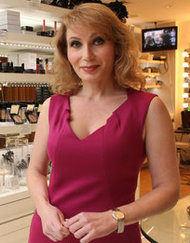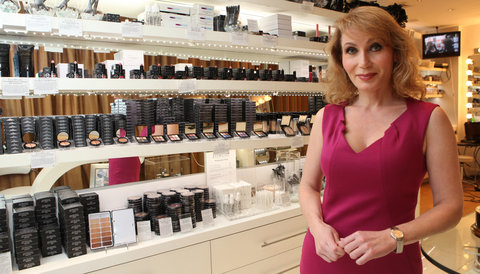Case Study
What would you do with this business?
 Chester Higgins Jr./The New York Times Eve Pearl
Chester Higgins Jr./The New York Times Eve Pearl
Last week, we published a case study about Eve Pearl, an Emmy-winning TV makeup artist who founded a cosmetics company by the same name. In June 2011, with online sales and traffic at her three-year-old Manhattan boutique slower than desired, Ms. Pearl, 46, listened hard when ShopNBC, the nation’s third-largest 24-hour home shopping network, invited her to appear live with some of her high-end products.
She weighed the pluses: her experience in front of the cameras on several “Today” show product demos and a potential audience of tens of millions. And she considered the negatives, among them: a possible worsening of cash flow because of the shopping network’s payment terms and the fear of tarnishing her top-drawer brand in the hurly burly of home shopping TV.
Last October, Ms. Pearl stepped in front of the ShopNBC cameras, first at midnight, then again at 2 a.m. and 7 a.m. She returned to the networks’ Minnesota studios the following month and has reappeared every month or so, as recently as last weekend. The exposure has had direct and indirect benefits. Ms. Pearl estimates home shopping sales will reach seven figures this year — and represent about a third of her total revenue. And rather than losing any luster because of this added sales venue, she feels her brand is sparkling even more. “Traffic both in the store and on our Web site spikes every time I’m on air — about 30 percent,” she said.
Did you feel that you might be gambling the future of your company with those live appearances?
No, I felt very confident appearing on air with my products. Makeup is a very visual, emotional product and you can see the results happening right in front of your eyes. It’s not like you have to wait a few weeks or months to see the results. Doing live makeovers on the “Today” show and at trade shows, my experience has been, people see it and that’s how they fall in love with it.
One of your concerns about selling your goods this way was a possible cash-flow problem. Did this happen?
Yes, we did face cash-flow problems. We went to Citibank and took out a small-business loan, because it took about six months to start seeing our first significant payments coming in.
And you’re now cash-flow positive?
Yes.
How many ShopNBC appearances have you made?
I’ve been on a couple dozen times. Sometimes we’re on for as long as an hour, sometimes we’re on three times for 15 to 20 minutes each time.
What would be your advice for someone thinking of selling products on a home shopping network?
It’s important to realize this can’t be your only sales route, because if it doesn’t sell here, you have to have another channel of distribution. Your stuff might not move — so what are you going to do with it when it all gets sent back to you, on your dime? That’s why people are so afraid of it. It can make incredible successes, but it also can cause the B-word: bankruptcy.
I also think it’s wise to start by testing the waters with only a couple of hero items. Our hero items are our high-definition dual foundation and our salmon concealer. Not only do they continue to sell for us, but they’re available on auto delivery. Customers receive the product every two months and they’re automatically charged. We’re up to four items now on auto delivery.
That’s the holy grail, right?
Exactly. That’s the goal, really. To have things go on auto delivery where you don’t even have to appear. As buyers develop more trust and loyalty to your brand, they’re apt to try more new products and more of the unique things like lipsticks and mascaras.
Do you have auto delivery on your own Web site?
We do not, right now, offer auto delivery. We are working on that.
Several readers echoed the Prtty Peaushun creator Bethany Karlyn’s suggestion for a makeover of your current Web site. Do you agree?
I absolutely agree. My Web site does need a makeover. It’s not clean and user-friendly, and the experience is not as smooth as I would like it to be. It’s like a candy store, which is not what we’re about. I’ve wanted to do auto delivery for a year. It’s frustrating. I’d love to find someone who can help me make the Web site that I have in my head.
Are there any indications that you tarnished your brand or cannibalized your Web business?
No, I really think we’ve kept our high-end brand image. It’s not like we’re selling millions of pieces. When I appear on air, one of my Emmy awards is sitting there. I challenge any high-end brand to provide a better-quality product with better education and better service. In fact, actually, every time we appear on ShopNBC, our Web sales increase — even though they’re offering our products at lower pricing.
What percentage of your 2012 sales do you expect will come from ShopNBC?
Right now, the purchase orders that have gone out represent about one-half of our business. The money that comes back is about one-third of our revenue. I’m happy with that, because it’s also allowed us to test out that market, and that will enable us to take this sales model into other countries, like QVC Canada or QVC UK. We hope to get into Canada before the end of the year.
A version of this article appeared in print on 10/04/2012, on page B8 of the NewYork edition with the headline: High-End Brand Tries ShopNBC.
Article source: http://boss.blogs.nytimes.com/2012/10/03/a-high-end-brand-tries-a-different-sales-channel/?partner=rss&emc=rss
